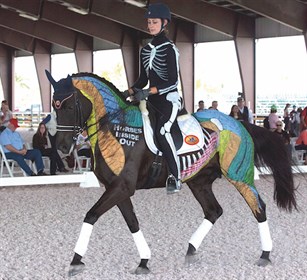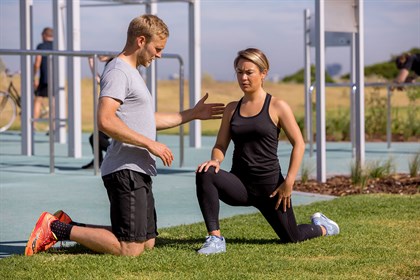
This article was first published in a previous edition of Equestrian Life. To see what's in the current issue, click here.
By Helen Fletcher // Photography by Dreamstime
Equestrian Pilates specialist, Helen Fletcher, gets you started with the basic exercises that enhance central (core) stability to enhance riding ability and enjoyment.
Like any fitness regime, an understanding of how and why we undertake a particular pursuit and then employing those techniques to improve our individual fitness and enjoyment, is extremely important. Pilates is particularly suited to assisting riders to achieve good posture for quality and economy of movement.
You can also seek an assessment of your personal concerns or exercise needs to address a particular riding issue. To get started on a regular programme, we look at what we are trying to achieve, why we do it and the core exercises.
What is it?
The recruitment of the deep stabilising muscles – Transversus abdominis, Pelvic Floor, Lumbar Multifidus and the Diaphragm, all working together to provide a cylinder of support and protection that strengthens and dynamically stabilises the spine.
- The strengthening of these deep stabilising muscles allows the limbs to move with freedom, fluidity and independence.
- All healthy functional movement should emanate from a strong stabilised centre.
Why do it?
- Improves posture, stabilises your seat and makes for easier application of the aids.
- Reduces your risk of injury and wear and tear on your joints.
- Improves strength and stamina.
- An intelligent approach to exercises helping you to ride smarter, longer.
- Improves flexibility and balance.
- Riders who lack central (core) stability are more likely to grip with their hips and legs, or stabilise themselves with their hands and therefore the reins.
How do I start?
- Lie on your back on a mat or folded blanket for comfort.
- Place your feet hip width apart and be sure you are in a neutral spine position. (see neutral spine in semi-supine)
- Inhale wide and full into the back and sides of your ribcage, feel the ribcage expand laterally.
- Exhale as you gently contract your pelvic floor muscles, continue to draw them up inside, as you do so you should feel your lower abdominals hollow and tighten slightly.
- The spine should remain still, and the buttocks relaxed.
- To engage your pelvic floor muscles women should feel as if they are stopping the flow of water, and for men think of lifting you crown jewels.
- Remember no more than 30% of your maximum contraction is required.
- In the exercises that follow and in consecutive articles I will refer to this as ‘engage your centre’
- If you have trouble with the activation of the pelvic floor muscles just focus on gently hollowing or scooping your abdominals towards your spine.
Stability Ball seated balance: Functional stability, balance.
- Sit upright on the ball, feet hip bone width apart.
- Ensure your pelvis and spine are in a neutral position, the pubic bone and hip bones should be on the same plane and the spine should be lengthened tall whilst maintaining its natural curves. Stack the boxes of your pelvis, ribcage and head centrally over one another.
- Lengthen through the crown of your head as if being gently pulled up by an imaginary ponytail, gently engage your centre.
- Have a sense of length across the front of the shoulders and allow the arms to hang freely.
- Find and maintain an even balance of pressure under both sit bones.
- Keep your centre engaged as you inhale and exhale for 5 -10 breathes, keeping your shoulders relaxed and your breathe flowing freely into your back and side ribs.
Stability Ball Leg Floats: Functional stability, balance, co-ordination and disassociation.
- From the seated balance position as above.
- Exhale and engage your centre and float one leg, aim to maintain an even distribution of weight under your sit bones, stay lengthened through both sides of your waist.
- Make the movement with lightness and ease, the focus on length throughout the spine will help this.
- Inhale as you lower the leg
- Repeat 10 times, alternating sides.
- To progress this exercise, challenge your balance and have fun gently bounce in a two time trot rhythm whilst you float alternate legs.
Neutral Spine in 4 Point Kneeling:
- Kneel on all fours, place your hands directly under your shoulders and your knees directly under your hips.
- Lengthen from the top of your head to the tip of your tail, allow the natural curves of the spine.
- Have a sense of pushing the floor away from you slightly with your arms so as not to collapse your upper back, lengthen your neck and very gently nod your chin.
- Engage your centre. As you are working against gravity here and lifting the abdominals up towards the spine it makes it very clear to feel what is happening.
- Maintain a neutral, stable spine and pelvis, no arching or tucking.
Table Top: Spine and shoulder stability, balance and co-ordination:
- From the 4 Point Kneeling position place an imaginary glass of water on your lower spine and do not allow it to spill in any direction.
- Inhale to prepare for movement.
- Exhale and engage your centre as you slide a weightless leg out behind you keeping contact with the mat. Maintain the stability of the pelvis.
- Inhale, keep your centre engaged.
- Exhale as you lengthen and lift the leg to hip height and simultaneously lengthen and lift the opposite arm. The shoulder will naturally elevate slightly but do not overdo this, maintain length between your shoulders and your ears.
- Inhale.
- Exhale as you lower your arm and leg back to the mat, sliding your leg back into the start position.
- Repeat 10 times alternating sides.
CO-ORDINATION AND CROSS CO-ORDINATION EXERCISES ARE BRILLIANT FOR RIDERS BECAUSE WE ARE ALWAYS DOING DIFFERENT THINGS WITH ALL 4 OF OUR LIMBS.
10 -15 MINUTES PER DAY OF MINDFULL PILATES PRACTICE WILL MAKE A HUGE DIFFERENCE TO HOW YOUR BODY FEELS AND FUNCTIONS IN EVERYDAY LIFE AND WHEN YOU ARE RIDING.
READ THE LATEST NEWS ARTICLES HERE
https://www.equestrianlife.com.au/articles/Laying-the-foundation


